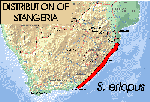
Distribution of Stangeria (1).
Common Names
Natal grass cycad (3).Taxonomic notes
The sole species in Stangeria T. Moore 1853. The genus was described based on a living specimen collected by Max Stanger, Surveyor-General of Natal Province, in 1851. The most recent analysis has been provided by P. & E. Vorster (2). When collected, it was initially thought to be the fern Lomaria coriacea; subsequently described by Kunze in 1829 as Lomaria eriopus and reaching its present nomenclature in 1892. Also known ca. 1853-1892, as S. paradoxa T. Moore (1, 3).Description
A small cycad with a subterreanean, carrot-shaped stem to 20 cm across. Stem may branch dichotomously at right angles to form many growing points. Roots swollen, fleshy, almost tuberous. Mature leaves 0.3-2 m long, pinnate, fern-like, erect or arching, dark green, glabrous; petiole 10-80 cm long, swollen and hairy at the base, smooth and lacking prickles; leaflets 10-40 on each leaf, 7-50 cm × 1.4-6 cm, linear-lanceolate to lanceolate, thin-textured to slightly leathery, proximal leaflets stalked, distal ones fused and decurrent on the rachis, margins entire or sometimes revolute, deeply lobed, prominently toothed or wavy, apex acute but readily broken off. Male cones 10-25 cm × 3-4 cm, narrowly cylindrical, solitary on each growing point, covered with short silver hairs when young, yellowish brown when mature; sporophylls about 12 mm across, triangular to rhomboid, lacking prickles; peduncle 5-25 cm long, hairy when young. Female cones 8-35 cm × 6-10 cm, ovoid to ellipsoid, covered with silvery hairs when young, dark green and less hairy at maturity; sporophylls to 6 cm across, slightly convex, overlapping; peduncle 5-25 cm long, hairy. Seeds radiospermic, 3-3.5 cm × 2-2.5 cm, ovoid to obovoid, the sarcotesta purple-red when ripe (1).Range
Southeast coast of South Africa between 27°S and 33°S and within 50 km of the sea, although remote from salt spray. Habitat open and dense evergreen forests, and short grassland. Soils includes sands and heavy black clays. Rainfall 750 to 1000 mm, with a summer maximum. Frosts are rare (1).Big Tree
Grows as a shrub, less than 2 m tall.Oldest
Captive plants may cone in four years (1), suggesting the species is relatively precocious (as cycads go).Dendrochronology
Ethnobotany
A popular ornamental, easily grown indoors in pots (1).Observations
Seen at Flecker Botanical Gardens in Cairns (Australia), March 1996. I suppose it's quite common in botanical gardens.Remarks
Morphology varies considerably with habitat. Plants from the frequent-fire open grassland habitats have usually one erect, compact leaf per crown with short, leathery leaflets. Crowns are much-branched. Plants from forested habitats have up to six leaves that have thin-textured, entire leaflets and less frequent cone production. S. eriopus is the only cycad known to not produce heat in the mature cones. The mature cones do produce a fruity odor. Sex change has been reported in captive plants (1).This species is fully protected under Appendix I of CITES (the Convention On International Trade In Endangered Species Of Wild Fauna And Flora (1973, revised 16-Apr-1993)).
Citations
(1) Jones 1993.(2) Vorster, P. and E. Vorster. 1986. Encephalartos 2: 8-17.
(3) Exotica 4 by AB Graf.
[Stangeria] [Stangeriaceae] [home]
This page is from the Gymnosperm Database
URL: http://www.geocities.com/RainForest/Canopy/2285/st/st/index.htm
Edited by Christopher J. Earle
E-mail:earlecj@earthlink.com
Last modified on 27-Jan-1999